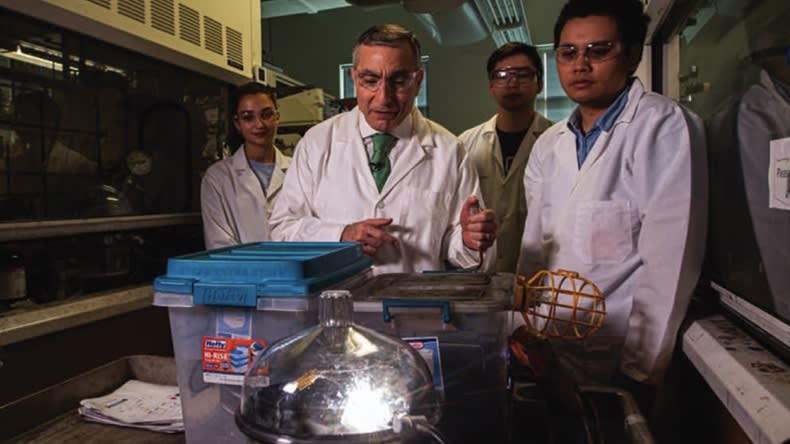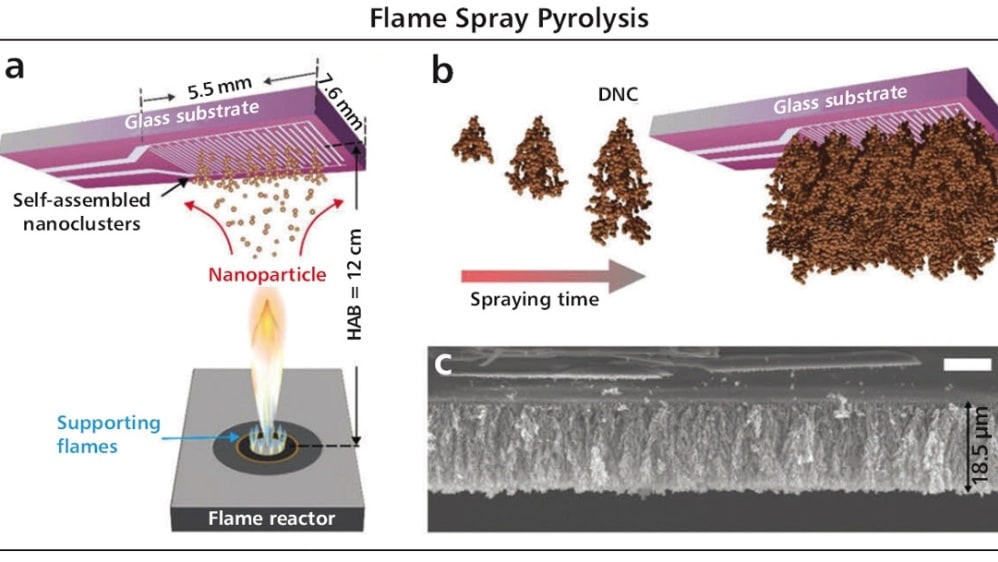
A team of researchers from the University of Nottingham's School of Chemistry, University of Birmingham, University of Queensland, and University of Ulm, has designed a material made up of copper anchored on nanocrystalline carbon nitride. The copper atoms are nested within the nanocrystalline structure, which allows electrons to move from carbon nitride to CO2, an essential step in the production of methanol from CO2 under the influence of solar irradiation.
In photocatalysis, light is shone on a semiconductor material that excites electrons, enabling them to travel through the material to react with CO2 and water, leading to a variety of useful products, including methanol, which is a green fuel. Despite recent progress, this process suffers from a lack of efficiency and selectivity.
The researchers devised a process of heating carbon nitride to the required degree of crystallinity, maximizing the functional properties of this material for photocatalysis. Using magnetron sputtering, they deposited atomic copper in a solventless process, allowing intimate contact between the semiconductor and metal atoms.
“We measured the current generated by light and used it as a criterion to judge the quality of the catalyst,” said Tara LeMercier, a student who carried out the experimental work at the University of Nottingham, School of Chemistry. “Even without copper, the new form of carbon nitride is 44 times more active than traditional carbon nitride. However, to our surprise, the addition of only 1 mg of copper per 1 g of carbon nitride quadrupled this efficiency. Most importantly the selectivity changed from methane, another greenhouse gas, to methanol, a valuable green fuel.”
Here is an exclusive Tech Briefs interview — edited for length and clarity — with University of Nottingham School of Chemistry Professor Andrei Khlobystov.
Tech Briefs: Can you explain the process in simple terms please?
Khlobystov: Our catalyst is suspended in water saturated with carbon dioxide while being illuminated. The process begins with the absorption of light by the semiconductor (carbon nitride), which causes an electron to move to a higher energy level (the conduction band). The electron then moves to the surface and transfers to a metal atom (copper) located on the surface of the semiconductor particle. At the same time, the copper atom binds a CO2 molecule dissolved in water.
Subsequently, the electron moves from the copper atom to CO2, creating a highly reactive anion-radical species. This species then undergoes a series of chemical transformations, reacting with hydrogen ions in water (protons) and receiving additional electrons from the catalyst. To produce one molecule of methanol, CO2 must receive six electrons and six protons, while losing a molecule of water. Once the reaction is complete, the molecule of methanol diffuses away from the catalyst into the liquid.
Tech Briefs: What was the biggest technical challenge you faced while developing this method?
Khlobystov: Our catalyst consists of two parts: semiconductor particles and metal atoms. The main technical challenge is to ensure a high-quality contact between the metal atoms and the semiconductor. This is critically important for the electron transfer from the semiconductor to the metal atom and from the metal to the CO2 molecule, as described above.
We achieved this by carefully controlling the preparation of carbon nitride so that it has areas of crystallinity at the nanoscale, which can effectively bind copper atoms. Additionally, we used the solvent-free method of Cu atom deposition, where atomically dispersed metal by a method called magnetron sputtering 'rains' down onto carbon nitride particles.
Tech Briefs: Do you have any plans for further research/work/etc.?
Khlobystov: Yes, certainly! In this research, we have just started to understand the relationship between metal atoms and semiconductor at the nanoscale in the CO2 photoreduction reaction. This system seems to be highly adjustable, and by modifying the structure (e.g., crystallinity of carbon nitride) or using different metals, we may discover pathways for producing other products from CO2, such as ethanol, which is even more valuable than methanol.
Tech Briefs: Going from that, what are your next steps?
Khlobystov: We have an immediate task at hand: extending the lifetime of our catalyst under the reaction conditions. It's important to maximize the amount of methanol produced per gram of the catalyst over extended periods to get the best value for our money. This is a critical step in translating our discovery to a larger scale.
Tech Briefs: Do you have any advice for engineers/researchers aiming to bring their ideas to fruition?
Khlobystov: From my experience, collaborating with colleagues from different disciplines can accelerate the realization of research ideas. Working with someone outside your research area broadens your experimental opportunities and is also highly enjoyable.
Tech Briefs: Anything else you’d like to add?
Khlobystov: It is essential to consider sustainability when innovating in the fields of science and engineering. In the realm of catalysis, it is crucial to not only create an effective catalyst but also to ensure that it is composed of earth-abundant elements and is produced in the most energy-efficient manner.
Our research is part of the major U.K. project 'Metal atoms on surfaces and interfaces (MASI) for sustainable future', which is funded by the Engineering and Physical Sciences Council. MASI project aims to tackle the sustainability challenge in catalysis by introducing innovative methods for creating catalysts using readily available chemical elements.





















